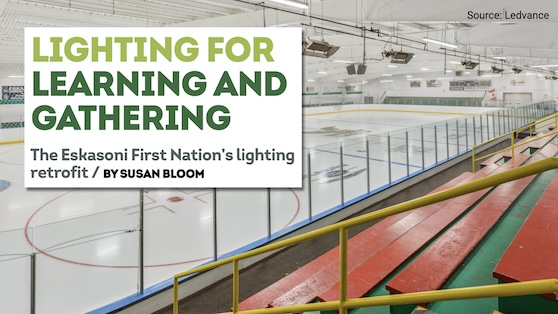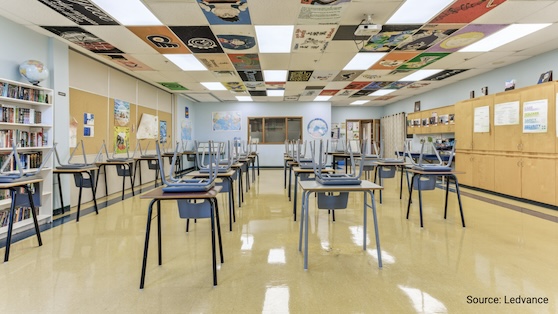
Articles
Features
Indigenous
Articles
Electrical
Energy Manager
Lighting & HVAC
Lighting for learning and gathering – the Eskasoni First Nation’s lighting retrofit
January 2, 2024 | By Susan Bloom
 Arenas create climatic challenges for fixtures, so vapour-tight, IP65-rated LED high-bays were retrofitted into this space.
Arenas create climatic challenges for fixtures, so vapour-tight, IP65-rated LED high-bays were retrofitted into this space. January 2, 2024 – Nestled within the rugged and beautiful terrain of Eastern Cape Breton Island in the Province of Nova Scotia, alongside Bras d’Or Lake, is the Eskasoni First Nation—the largest Mi’kmaq community in the world.
A community with a rich culture and history, the Eskasoni FN—which translates to “where the fir trees are plentiful” in Mi’kmaq—is nearly 5000 members-strong, and operates everything from a bustling K-12 school system and robust network of private-sector businesses to a supermarket, radio station, community ice rink, and cultural centre.
The Eskasoni community feels connected to, and is respectful of, its environment—a value reflected in its 1999 launch of The Unama’ki Institute of Natural Resources (UINR), which is a non-profit organization that promotes stewardship of local waterways, forests, native species, protected areas, and other natural resources in Cape Breton.
Having driven everything from solar installations to water conservation projects and more throughout the community, it came as no surprise that the Eskasoni FN turned its attention to upgrading the outdated fluorescent lighting within several important community buildings.
The need for retrofit is clear
The community’s two school buildings and ice hockey arena/community centre were lit with outdated T12 and T8 fluorescent fixtures.
According to Jeffrey Paul, supervisor, Maintenance & Transportation for the Eskasoni School Board, the high costs and upkeep of outdated lighting in the community’s two school buildings—a 50-year-old elementary/middle school building housing 700 students, and a 25-year-old high school building housing 270 students—were adding up.
“From a maintenance perspective, we were paying quite a bit of money to replace our fluorescent lamps as they reached their end-of-life,” shared Paul. “At the same time, lamps in a few of our classrooms flickered and caused some students to experience seizures and other health problems.”
“In addition to issues in our classrooms, the lighting fixtures in our gym had a strange greenish-yellow cast to them, which ruined pictures that we took of our Christmas concerts there,” noted Elizabeth Cremo, director, Education, for the school board. “As a result of the flickering and odd colouring from some of the older lamps in both schools, teachers or students often opted not to replace failed lamps and/or to shut off half of the lights.”
Not surprisingly, Cremo continued, this situation created challenges for students with low visual acuity, “which concerned us because we didn’t want to make the learning environment more challenging than it naturally is for students”.
Thankfully, there was a change in the air.
“We were informed that current product rebates made it more attractive to pursue an LED upgrade than it had been a few years earlier, so we were motivated to go to the school board with a proposal,” Paul said happily. “We explained to them that it would be financially beneficial for us to undertake the upgrade now, and they wholeheartedly agreed.”
Partnering for success
Paul and his colleagues at the school board turned to their partners at electrical distributor Rexel Atlantic, who had informed them of the upgrade opportunity in the first place.
“We started this project with the Eskasoni School Board several years ago,” said Michael Orychock, outside sales specialist, Rexel Atlantic in Cape Breton. “I made them aware of incentives available through Efficiency Nova Scotia and thought it would be a great opportunity for the schools because, based on their use of outdated T12 and T8 fluorescent lighting—and the fact that several fixtures were out in each classroom—they definitely needed a lighting upgrade.”
In 2020, Orychock and his colleagues—including Rexel Atlantic lighting specialist Phil Deal—got to work assessing the existing lighting configuration in the Eskasoni schools, and designed a high-performing, energy-efficient new system featuring LED fixtures.
The solution takes form
Following approval from the board, electrical installers from Rexel kicked off the upgrade in 2021 by replacing the system of 3-lamp, 32W fluorescents in the elementary/middle school with 1200 2×4 LED lay-in panels.

Prior to the lighting retrofit, the lamps in a few of the classrooms flickered and caused some students to experience seizures and other health problems.
The new LED system cut the school’s lighting energy bill in half.
“The previous cost of the energy to run the school’s lighting was $114,500 annually, which the new LEDs reduced to less than $57,000 annually after the upgrade,” said Deal, adding that “Thanks to product rebates of $27,000 on the LEDs, the project paid itself back in just 1.25 years” and successfully reduced the school’s energy consumption by 512,000 kWh.
In 2022, the retrofit team proceeded to upgrade the outdated T5 high-output fluorescent lights in the hockey arena.
“The hot lights, crowds, and sub-zero temperatures in this facility create climate challenges for fixtures, which can suffer from the effects of humidity, condensation, and rust if water penetrates their housing,” said Orychock, who added that the facility’s high ceilings make lighting maintenance difficult—and costly, as well.
As such, vapour-tight LED high-bays were selected for the arena retrofit. Their IP65 rating means that not only are they dust-tight, but that water projected in jets against the fixtures will have no harmful effect.
Add to that a durable polycarbonate housing, long maintenance-free life and powerful light output, Orychock says the fixtures “addressed all of those concerns”.
In late 2022, the contracting team kicked off the lighting upgrade in the community’s high school, where they replaced outdated 28W fluorescent lamps with LED panels, strip fixtures, and linear high-bays. Once completed, said Deal, “this upgrade will reduce the school’s $42,000 annual power bill for lighting to just $21,000 each year and, thanks to the additional availability of a $25,000 rebate on the LEDs, will pay itself back in just 1.25 years”.
Lighting for learning
“The teachers like the new lighting, and say that it brightens everything and makes the schools’ classrooms and common areas look clean, comfortable, fresh, and inviting,” Orychock said.
Eskasoni School Board members Jeffrey Paul and Elizabeth Cremo agree—they couldn’t be happier with the results.
“We have a small maintenance crew for two schools, and replacing lamps was time-consuming for them but, since we upgraded our schools’ lighting, we haven’t had to change one fixture,” Paul said.
“Our faculty and students have been amazed at the difference in the brightness compared to the old lighting and it’s enhanced their ability to learn. And with our students no longer complaining of headaches from flickering lamps, the new lighting also promotes their well-being,” he added.
Cremo added that the lamps’ sustainability is another important benefit.
“We’re very proud of where we live and want to do the best we can for the land that we live on and leave to our kids,” Cremo explained. “As a result, we’re very focused on our carbon footprint and always try to make the best choices from an environmental perspective. The fact that LEDs consume less energy, are mercury-free, and are very long-lasting—which reduces waste in landfills—made this upgrade a no-brainer for us.”
“The Eskasoni First Nation has an amazing track record of achievements in sustainability, and we’re delighted to have been part of such a prominent and successful project and to help support their lighting and sustainability goals,” said Ed Evans, national account manager with Ledvance, whose products were used in the retrofits.
“I’ve been working with the Eskasoni First Nation for 30 years and have many good friends there,” Orychock added. “It’s an honour to have helped bring about this accomplishment, which will benefit their community for years to come.”
Members within the Eskasoni First Nation are enjoying the high-performing, energy-efficient, and long-lasting benefits of LED lighting, and the community’s schools and ice rink now present a more welcoming environment than ever in which to learn and and gather.
For his part, Paul hopes that others will be inspired by his community’s achievements.
“I’d absolutely encourage other communities and school systems to undertake an LED upgrade because the savings speak for themselves,” he said. “These upgrades reduce costs, support the environment, and promote the well-being of building occupants. Ultimately, they’re a win-win for everyone.”
You’ll find all Back Issues of Electrical Business Magazine in our Digital Archive.
Print this page
